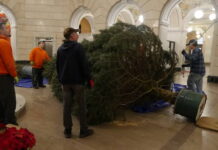DALLAS — There are no mountain lions in the Back Mountain or surrounding region, according to Pennsylvania Game Commission Officer Bill Williams.
Williams’ confirmation debunks rumors of a mountain lion shot behind JJ Banko’s Seafood in Nanticoke recently and a second sighting a month ago near B&E Motors in Hunlock Township.
“It (the report) is not likely,” Williams said noting mountain lions were present in northeast Pennsylvania in the 1870s, but no new credible evidence to support the big cats’ residency has been found.
The U.S. Fish and Wildlife Service reports eastern cougars, also know as mountain lions, were found in every eastern state from Maine to South Carolina. Early settlers in Northeastern Pennsylvania killed off many cougars, and diseases brought in by livestock killed much of the remaining population, according to the agency’s website.
Williams said Pennsylvania Game Commission officers never found mountain lion tracks, carcasses or waste droppings in the Back Mountain region.
Kingston Township Police Officer John Fuches heard the online rumors about a cougar shot behind the Nanticoke restaurant.
“It is not true,” Fuches said. “Mountain lion rumors develop every couple of years.”
Jackson Township Police Chief Balavage, who has served in law enforcement for 37 years in the Back Mountain, has never received a call about a mountain lion sighting.
“A mountain lion would be unique,” Balavage said. “Often a bobcat is mistaken for a mountain lion.”
Williams agreed, adding the region does have a “big bobcat population” and is also home to fishers, fox, coyotes and black bear.
An adult bobcat can grow to be 3 feet in length with a short, stubby tail and weigh between 15 to 35 pounds, according to the U.S. Fish and Wildlife Service website.
Adult mountain lions can range from 6 to 8 feet long, which includes their tail, and can weigh between 105 to 140 pounds, the agency’s website stated.
Williams also dispelled the rumor that the Pennsylvania Game Commission released cougars into the region 15 years ago to control the deer population.
“That is thoroughly untrue,” he said.
Balavage, Fuches, and Williams said it is more common to receive reports of black bears roaming through Back Mountain neighborhoods.
Black bears are active in the fall, foraging for food to bulk up for hibernation, Williams said. Black bears will not hibernate until late November with “sows, or female bears, and this year’s cubs hibernating first, then sows with last year’s cubs, juvenile males and finally adult males,” he said.
“We receive bear calls every day,” Williams said.
A black bear may choose to hang around a neighborhood base on food availability, Williams said.
He recommends removing bird feeders for several weeks, secure household waste in a closed garage or shed, clean outdoor grills and their grease traps.
“The primary goal is to remove the bear’s food source,” Williams said.
If hiking, Williams suggests singing or talking to make any bears in the vicinity know you are there and approaching.
“We have no reports of anyone being killed by a bear (in Luzerne County) in recorded history,” he said.




